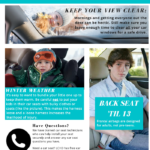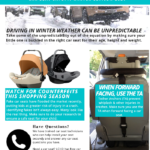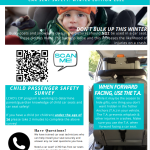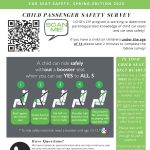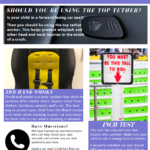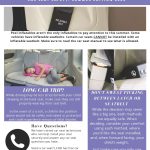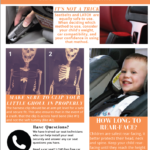The goals of the Maternal and Child Health (MCH) Division are to eliminate health disparities, improve birth outcomes, and improve the health status of Licking County’s women, infants, children, youth and families.
MCH Priorities:
- Decreasing childhood obesity, reducing food insecurity, and supporting breastfeeding;
- Decreasing infant mortality by ensuring infants have a safe sleep environment and car safety seats;
- Increasing parenting skills, promoting early childhood development and school readiness;
- Providing referrals to safety net services assure that the health needs of women and children are met;
- Addressing social determinants of health.

WIC
The Special Supplemental Nutrition Program for Women, Infants, and Children (WIC) program provides supplemental foods, health care referrals and nutrition education for low-income pregnant, breastfeeding and non-breastfeeding postpartum women, and to infants and children up to age five who are found to be at nutritional risk.

Breastfeeding Support
The LCHD Nursing and WIC programs work together to promote breastfeeding and to help mothers who choose to breastfeed with education, classes and peer support.

Early Head Start Home Visiting
Early Head Start provides home visits to families with children under the age of three whose income is below 100% of the poverty level. Our home visitors all have a background in Early Childhood Education and have been trained in parenting skills. Questions and referrals can be directed to LEADS Head Start at (740) 349-8606.
Program Highlights
Child Safety Seats
LCHD's Child Safety Seat program provides car seats for low income families without child safety seats. Parents are trained on proper installation and use of the seats and the seat is properly secured in the car by a trained child passenger safety technician. To see if you are eligible to receive a seat, please call (740)-349-6535 or click here for more information.
Child Passenger Safety Newsletters
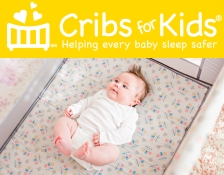
Cribs for Kids
The mission of Cribs for Kids is to prevent infant sleep-related deaths by educating parents and caregivers on the importance of practicing safe sleep for their babies and by providing portable cribs to families who, otherwise, cannot afford a safe place for their babies to sleep.

Parents: Tips for Raising Safe and Healthy Kids
Plan a healthy pregnancy: Take folic acid and avoid drinking alcohol to help prevent certain birth defects and disabilities. Know your family’s health history to see if you and your baby are at higher risk for certain diseases and conditions. Make sure any health conditions you have are under control and that you are up-to-date on your vaccinations.
Know the signs of child development: As your kids grow, they should reach milestones in how they play, learn, speak, and act. A delay in any of these areas could be a sign of a developmental problem. The earlier you recognize a delay, the more you can do to help your kids reach their full potential.
Get check-ups and vaccinations: Routine check-ups, including dental and eye exams, help identify ways to stay healthy, provide the opportunity to receive preventive services, and help find health problems early, when chances for treatment are better. Vaccinations help prevent many diseases and save lives. Keep track of your and your family’s check-ups and vaccinations to make sure they stay current.
Protect your kids: Take steps to make sure your home, car, school, and other areas are safe. Use car seats and seat belts for appropriate ages and sizes. Keep harmful substances and objects out of children’s reach. Be aware of signs of maltreatment, including physical, sexual, or emotional abuse. Ask a trusted friend or family member to watch your kids if you feel yourself losing control and need a break.
Provide healthy meals and snacks: Eating right will help provide the nutrients needed to have energy, build strong bones, and fight diseases and conditions. For babies, breastfeeding is best. As children grow, help them choose healthy meals and snacks. Pay attention to what and how much they eat. You’ll help them stay on track and may uncover problems of which you were unaware.
Keep your kids active: Help kids and teens be active for at least 1 hour a day. Include activities that raise their breathing and heart rates and that strengthen their muscles and bones. Find fun, safe, and active things you can do with your kids to help keep the whole family healthy.
Live a smoke-free life: Smoking and exposure to secondhand smoke are harmful to you and your family. Be smoke-free during pregnancy to help prevent premature birth and other health problems. Stay smoke-free to help lower your children’s risk for sudden infant death syndrome (SIDS), bronchitis, more severe asthma, ear problems, and pneumonia. You can help protect your children by making your home and vehicles smoke-free. Quitting smoking is the single best way to protect your family.
Monitor activities: Kids learn from family, friends, media, school, and more. Know who they spend time with, what they are doing, and whether their activities are age-appropriate. Discourage TV viewing for children under 2 years of age, and limit TV viewing to no more than 2 hours per day for children 2 years and older. Know how their schools promote health and safety.
Teach your kids healthy habits: Help your kids develop skills to make safe and healthy choices every day. These include fastening seat belts, wearing helmets, applying sunscreen, brushing teeth, washing hands, forming healthy relationships, and more. Make safe and healthy choices every day to show kids how to do it.
Provide love and support: Kids need the support and love of family and friends. Talk to your kids to help them understand how they can be healthy, safe, and happy. Find out what’s going on with them and how they are making decisions and handling problems. Respond to their physical and emotional needs. It’s important for kids to develop in a safe, loving, and secure environment.

